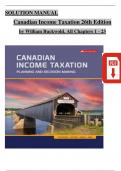Exam (elaborations)
Solutions Manual for Canadian Income Taxation 2023/2024, 26th Edition by William Buckwold, ISBN: 9781264909551, All 23 Chapters Covered, Verified Latest Edition!!!!
Solutions Manual for Canadian Income Taxation 2023/2024, 26th Edition by William Buckwold, ISBN: 9781264909551, All 23 Chapters Covered, Verified Latest Edition William Buckwold, ISBN: 9781264909551 Solutions Manual for Canadian Income Taxation 2023/2024, 26th Edition by William Buckwold, ISBN: 978...
[Show more]




